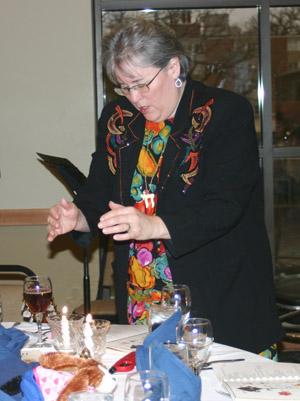
By Barb Arland-Fye
Rabbi Henry Karp was in his element: teaching students about the rituals and traditions of the Jewish faith at St. Ambrose University in Davenport. But this lesson was different. The rabbi was teaching about and leading a Passover Seder — a meal that celebrates the Jewish people’s freedom from slavery in Egypt — and his students included Bishop Martin Amos of the Davenport Diocese, priests, students and faculty of the university.
It wouldn’t have happened without Ian Ross, a 20-year-old St. Ambrose student who organized the Passover Seder as a way to share and celebrate his faith with the university community. He asked Rabbi Karp, an instructor at St. Ambrose for 24 years, to lead the Seder on March 24 in conjunction with the university’s Multicultural Week. The actual observance of Passover begins on the evening of April 8.
“I’m thrilled to be at this Seder with you,” Rabbi Karp told a gathering of 105 people at the Rogalski Center on campus. “My wife (Cantor Gail Karp) and I are going to walk you through a typical Passover Seder.”
And they did — through storytelling, song and laughter because the Passover Seder “is essentially the Jewish Fourth of July,” Rabbi Karp said.
At the center of each table was a Seder Plate, containing foods symbolic of the Passover story: unleavened bread, parsley, bitter herbs, a sweet mixture of apple and nuts, a roasted bone and a hard-boiled egg.
Participants dipped parsley, a symbol of spring and rebirth, into salty water, a symbol of the tears of the slaves. The rabbi broke in half a square of matzah to symbolize incompleteness, the need to repair the world. At each table, guests passed the Seder plate and took a piece of matzah. “Sharing bread forms a bond of fellowship,” the rabbi said.
During the Maggid, or narration of the Passover, Rabbi and Cantor Karp encouraged participation in the story. Guests read along in a book called the Haggadah and sang songs, some in Hebrew and some in English.
Dinner began about an hour and a half into the storytelling and featured matzah ball soup, salad, potatoes, chicken and sponge cake. The storytelling continued afterward. A child held open a door for a few minutes because legend has it that Elijah the prophet visits every Passover Seder. The group raised a cup of wine (grape juice in this case) to honor Elijah and pray for his return, bringing a time of peace and freedom.
“It was a unique experience,” St. Ambrose sophomore Miles Chiotti said of the Seder. “It opened you up to a culture and a faith, and it’s such an ancient faith.”
Rachel Lagerstam, 14, attended the Seder with her twin brother, Dylan, and her dad, Leon, who was covering the event for his newspaper.
She appreciated learning about the similarities and differences between Judaism and Christianity. Referring to the symbolism of wine, she said, “I’m Lutheran. I believe it’s the blood of Jesus; for them, it’s a joy.”
Dylan said, “It was a great experience to find out how other religions work.”
Their dad said he wanted “to show them the universality of life and religion.”
Ross thanked everyone who helped make the Seder possible.
“If participation is an indication of success, then you have made the first St. Ambrose University Passover Seder a success.”
Bishop Amos, who received a personal invitation from Ross, said, “I am so glad I accepted it. I thought the rabbi did such a wonderful job of helping us to understand and appreciate the symbols and rituals of our Jewish brothers and sisters.”
Rabbi Karp was “quite honored that the bishop would take time out from his heavy schedule to share that experience with us.”
Bishop Amos’ “presence at the Seder was a very clear statement of his commitment to a positive Catholic-Jewish relationship in our community.”
Rabbi Karp had never before led a Passover Seder at St. Ambrose.
“I think if any faculty member did this, it wouldn’t have gotten the type of support that it received from students getting together and organizing it,” he said. “That really gave it life.”








